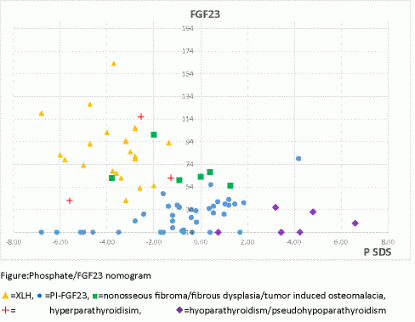ECEESPE2025 Poster Presentations Bone and Mineral Metabolism (112 abstracts)
The role of FGF23 in phosphorus and calcium metabolism: lessons from diseases affecting serum phosphate levels
Ilknur Kurt 1 , Mehmet Eltan 1 , Busra Gurpinar Tosun 1 , Belma Haliloglu 1 , Abdullah Bereket 1 & Serap Turan 1
1Marmara University School of Medicine, Department of Pediatric Endocrinology, Istanbul, Türkiye
JOINT2372
Background and Objective: Fibroblast Growth Factor 23(FGF23) is a phosphate regulating hormone primarily produced by osteoblast and osteocytes. Under physiological condition, FGF23 secreting cells sense the serum phosphate and regulate it in strict range by modulating FGF23 secretion in coordination with parathyroid hormone (PTH). Additionally, FGF23 inhibits both the synthesis and secretion of PTH, while PTH stimulates FGF23 secretion, underscoring the complex interplay between these hormones. In this study, we aimed to evaluate interrelationship between FGF23 and phosphate metabolism, along with other key regulators, by analyzing their levels in various diseases conditions. Additionally, we sought to develop an FGF23-Phosphate nomogram to facilitate a better understanding of these interactions.
Methods: A total of 79 blood samples from 77 patients were evaluated. Patients with X-linked hypophosphatemia(XLH[n = 22]), fibrous dysplasia (n = 3) and tumor induced osteomalacia/nonosseous fibroma (n = 3) were classified under phosphate independent FGF23 secretion (PI-FGF23[n = 29]). Conversely, patients with nutritional rickets (n = 6), SLC34A3/A1 mutations (n = 8), and nephrocalcinosis of unknown etiology, whose FGF23 levels were consistent with phosphorus levels, were classified under phosphate dependent FGF23 secretion (PD-FGF23[n = 41]). Additionally, patients with hypoparathyroidism/pseudohypoparathyroidism (HP/PHP[n = 6]) and hyperparathyroidism (n = 3) were evaluated as separate groups. Samples were collected from patients either before treatment or after the discontinuation of treatment. Serum FGF23 concentrations were measured using the Sandwich Immunoassay method.
Results: In PD-FGF23, FGF23 showed a positive correlation with P-SDS (r = 0. 634, P=<0. 0001) and Tmp/GFR (r = 0. 463, P = 0. 002); in contrast, no correlation was detected in PI-FGF23 group. Additionally, P-SDS demonsrated a negative correlation with ALP-SDS (r = -0. 554, P = 0. 0002) and PTH (r:-0. 585, P=<0. 0001) in PD-FGF23 group, whereas a positive correlation was observed between P-SDS and PTH (r = 0. 573, P = 0. 0053) in XLH group. Additionally, the P/FGF23 nomogram demonstrated that FGF23 levels were undetectable when serum phosphate <-3 SDS. Between -2 SDS and -3 SDS, FGF23 cutoff value of 30 could differentiate PI-FGF23 from PD-FGF23. Furthermore, patients with a homozygous SLC34A3 mutation exhibited undetectable FGF23 levels despite normal phosphorus levels. In HP/PHP group, FGF23 levels were inappropriately low relative to phosphorus levels, whereas in the hyperparathyroidism, FGF23 levels were inappropriately high relative to phosphorus levels.

Conclusion: Our findings suggest that FGF23 plays a pivotal role in phosphorus metabolism, with distinct regulation patterns depending on the underlying etiology of hyperphosphatemia or hypophosphatemia. The interplay between FGF23 and PTH is essential in maintaining phosphate homeostasis, yet neither can fully compensate for the absence of the other.
Keywords: FGF23, phosphate, Phosphate/FGF23 PTH
 }
}



